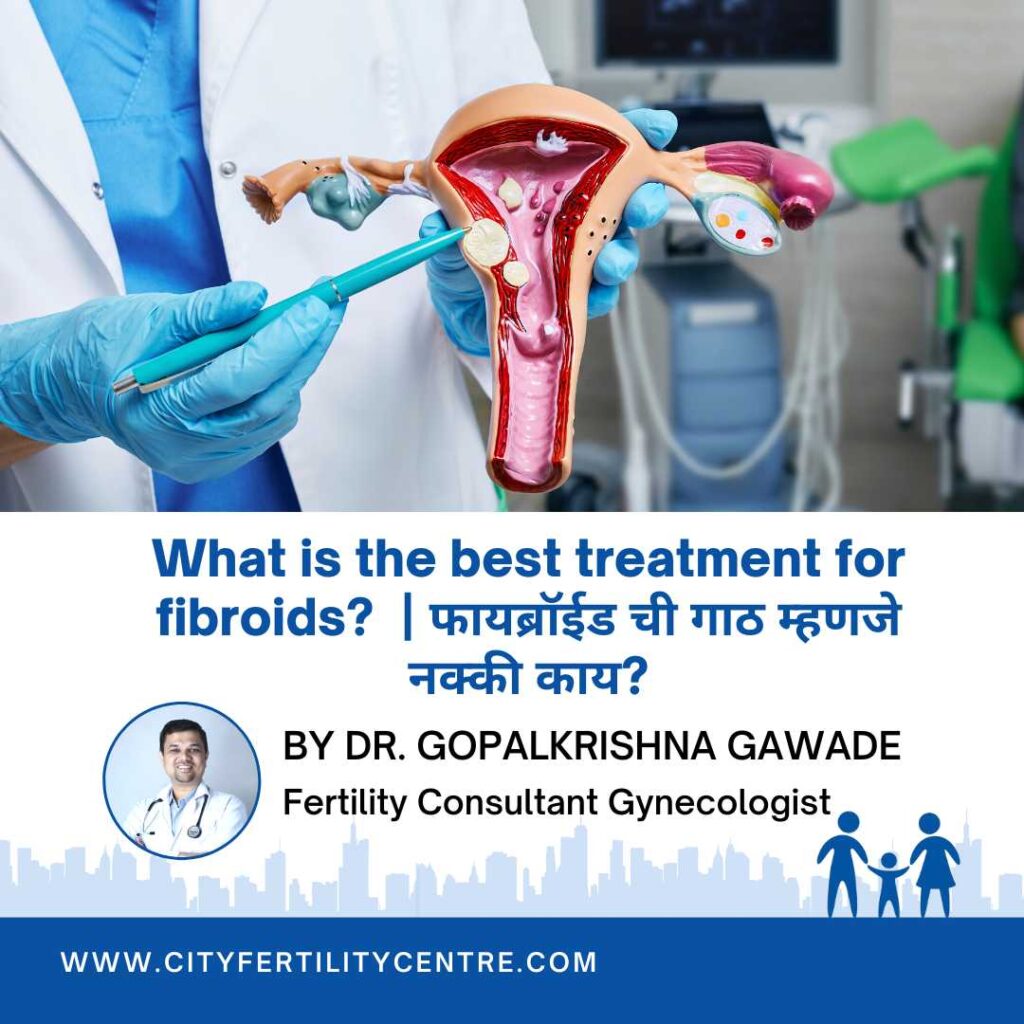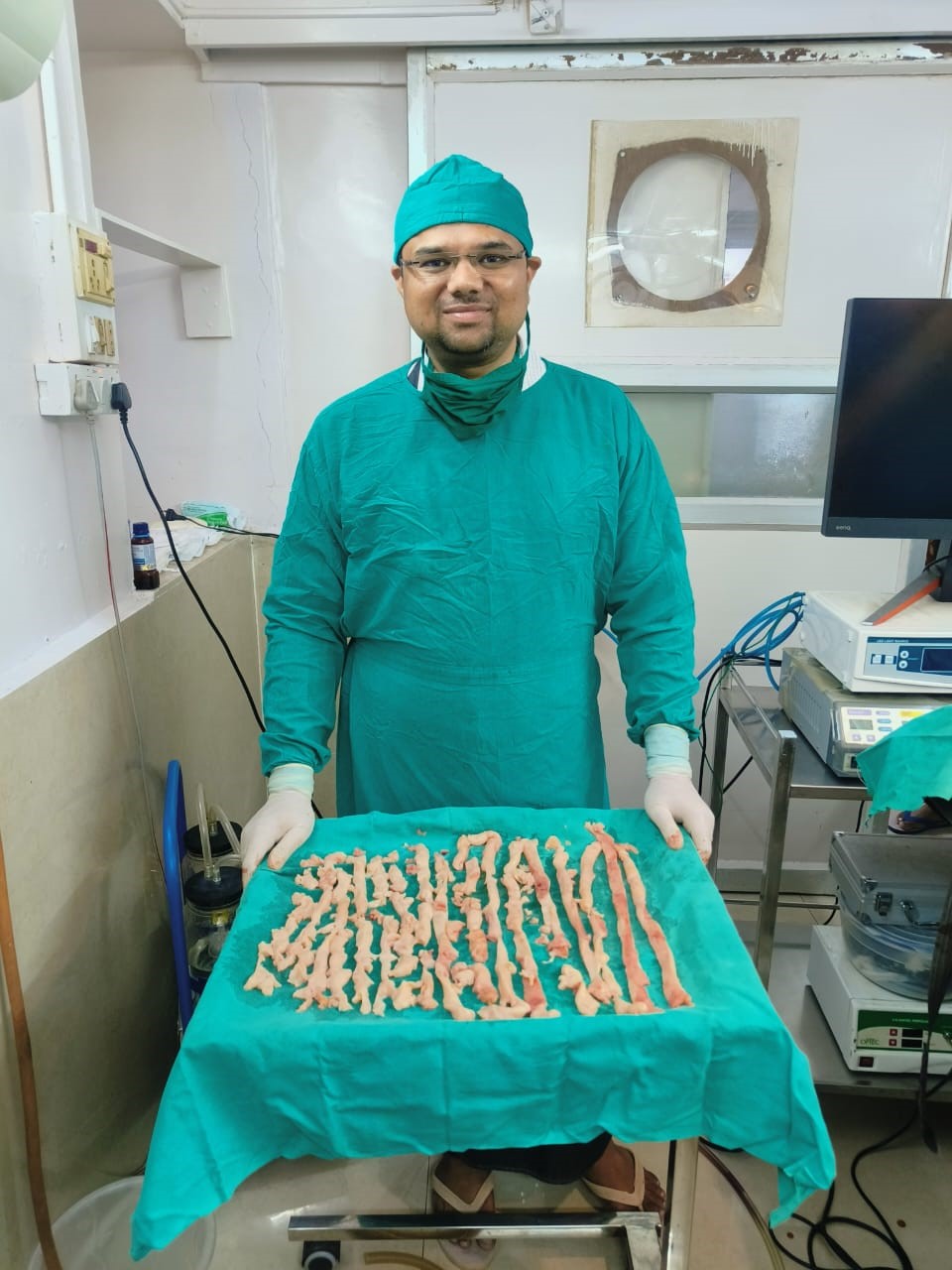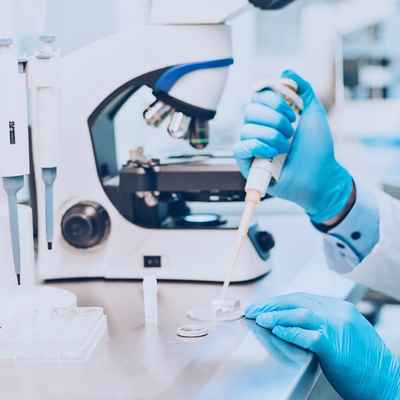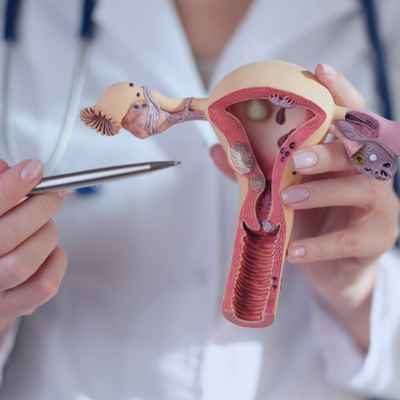Uterine fibroids, commonly known as leiomyomas or myomas, are uterine growths. They are constructed from uterine muscle. They are noncancerous and very common. In fact, 75 to 80% of women with uteri will develop fibroids at some point in their life.
A myomectomy is an operation to remove fibroids while preserving the uterus. It can be removed laparoscopically. But very few women require operation. Know more about it by Dr. Gopalkrishna Gawade (Laparoscopic Gynecologist.)
To read this blog in Marathi, choose language below.
In women who have symptoms, the most common signs and symptoms of uterine fibroids include:
• Heavy menstrual bleeding
• Menstrual periods lasting more than a week
• Pelvic pressure or pain
• Frequent urination
• Difficulty emptying the bladder
• Constipation
• Backache or leg pains
Fibroids are generally classified by their location. Intramural fibroids grow within the muscular uterine wall. Submucosal fibroids bulge into the uterine cavity. Subserosal fibroids project to the outside of the uterus.
When do fibroids need to be treated? The answer is fairly straightforward. If the fibroids are asymptomatic, or cause you no issues, treatment is probably not needed. Whereas, if your fibroids cause you pain and other problems, treatments are available for you to choose from depending on the severity of the symptoms.
Medications:
Medications for uterine fibroids target hormones that regulate your menstrual cycle, treating symptoms such as heavy menstrual bleeding and pelvic pressure. They don’t eliminate fibroids, but may shrink them.
Gonadotropin-releasing hormone (GnRH) agonists, Progestin-releasing intrauterine device (IUD), Tranexamic acid etc.
Minimally invasive procedures:
- Uterine artery embolization
- Radiofrequency ablation
- Laparoscopic myomectomy
In a laparoscopic myomectomy, four one-centimeter incisions are made in the lower abdomen: one at the belly button, one below the bikini line near the pubic hair, and one near each hip. The abdominal cavity is filled with carbon dioxide gas. A thin, lighted telescope is placed through an incision so the doctors can see the ovaries, fallopian tubes and uterus. Long instruments, inserted through the other incisions, are used to remove the fibroids. The uterine muscle is then sewn back together, the gas is released and the skin incisions are closed. You will be asleep for the procedure. The recovery is shorter than for an abdominal myomectomy typically, women spend one night in the hospital and two to four weeks recovering at home.
Medications:
Medications for uterine fibroids target hormones that regulate your menstrual cycle, treating symptoms such as heavy menstrual bleeding and pelvic pressure. They don’t eliminate fibroids, but may shrink them.
Gonadotropin-releasing hormone (GnRH) agonists, Progestin-releasing intrauterine device (IUD), Tranexamic acid etc.
Minimally invasive procedures:
- Uterine artery embolization
- Radiofrequency ablation
- Laparoscopic myomectomy
In a laparoscopic myomectomy, four one-centimeter incisions are made in the lower abdomen: one at the belly button, one below the bikini line near the pubic hair, and one near each hip. The abdominal cavity is filled with carbon dioxide gas. A thin, lighted telescope is placed through an incision so the doctors can see the ovaries, fallopian tubes and uterus. Long instruments, inserted through the other incisions, are used to remove the fibroids. The uterine muscle is then sewn back together, the gas is released and the skin incisions are closed. You will be asleep for the procedure. The recovery is shorter than for an abdominal myomectomy typically, women spend one night in the hospital and two to four weeks recovering at home.
Dr. Gopalkrishna Gawade of City Fertility Centre Pune is one of the most renowned laparoscopic surgeons in gynecology in Pune. He has more than 15 years of experience and has done more than 5000 laparoscopic surgeries. At City fertility Centre, we have most advanced laparoscopy equipment and experienced staff. Our well-planned protocols will help you to undergo laparoscopic surgery with utmost ease and at affordable rates.
To book appointment with Dr. Gopalkrishna Gawade. Call us at +91-8669993336.
Our Services
We provide comprehensive care for women of all ages. Right form the reproductive issues to post-menopausal gynecologic problems, every treatment related to female reproductive organs are provided here.
What People Say
About Us
Pallavi M
We got this reference through one of my friend, with full faith we visited the clinic for consultation. We had already taken consultation and treatment from many renowned gynecologist in Pune. Dr. Gopalkrishna Gawade Sir made us feel confident and comfortable in the first visit itself. He explained us the procedure and line of treatment.
Pooja Singh
I am very excited to writing this review. I was suffering from infertility from last 4 years .in this period I consulted so many Doctors but didn't get any result I was very disturbed .after search I met Dr. Gawde he made me relax and suggested some life changes modifications like yoga , suryanamaskar and prescribe some medicine. And after 6 month I got my test +very. Thanks to Dr. Gawade and Dr.Deepali.
Chaitrali Kulkarni
My experience of Hysterectomy by Dr Gawade was wonderful along with post operative care and his communication skills are also good. I am happy and satisfied with pre operative consultation and Surgical technique.
FAQ
It is the procedure of choice for those with fallopian tube issues, as well as for such conditions as endometriosis, male factor infertility and unexplained infertility.
Success rates strongly depend on the age of the patient, their condition, medical history and the treatment used. We have above 75% of success rate. With accurate diagnostics and holistic approach to relieve stress can increase the chances beyond 80%.
No. The procedure is not painful as it is done under light sedation, but may cause mild discomfort. At our clinic, we use mild anesthesia administered through an IV route which relieves discomfort.
There is no evidence that travel impacts IVF pregnancy rates.
Women have a 10 to 20 percent chance of getting pregnant with each IUI cycle. The more cycles you go through, the better your chances become.
Intracytoplasmic sperm injection (ICSI) is a technique used during in vitro fertilization (IVF) where a single sperm is injected directly into the egg for the purpose of fertilization.
Ideal candidates for ICSI include men with severe infertility issues, including a low sperm count. Other candidates include men who have sperm motility issues, problems with sperm development, or a blockage that prevents sperm from being ejaculated.
Yes, alcohol can lead to infertility in both men & women.
Laparoscopy still has an important role in the diagnosis and treatment of infertility. A significant number of infertile women, such as those with a tubal factor, PCOS, and women with unexplained infertility can benefit from it.
Most women go home 2-3 days after this surgery, but complete recovery takes from six to eight weeks.
Book Appointment with
Dr. Gopalkrishna Gawade
IVF specialist & Laparoscopic gynecologist
“More than half of all infertility cases are caused by stress. Here’s how to find peace in your life. Smile. Relax. Fall in love with yourself again, because you deserve it. Let us help you through this beautiful journey to attain parenthood.









